A Study of Leadership Skills for Group Conflict Management at Tesco UK
VerifiedAdded on 2021/11/10
|18
|3927
|24
Report
AI Summary
This research proposal investigates the leadership skills necessary for managing group conflicts within Tesco UK, focusing on the challenges presented by a multicultural workforce. The study aims to identify the causes of misunderstandings and disunity among employees, assess the effects of unresolved conflicts on production, consumer retention, sales, and ROI, and pinpoint effective leadership and behavior management approaches. The literature review examines the impact of ineffective leadership styles, communication barriers, imbalanced reward systems, and workplace diversity on conflict emergence. The proposal suggests strategies such as role division, enhanced communication, employee training, and fostering cohesion through events. The research will contribute to understanding how leadership can mitigate conflicts and improve organizational performance within a diverse corporate environment. The research also includes the research questions, aims, objectives, methodology, and ethical considerations.

Running head: Research Proposal 1
A study of leadership skills necessary for management of group conflicts at Tesco UK.
Name of Student
Name of Institution
Name of Course
Date of Submission
A study of leadership skills necessary for management of group conflicts at Tesco UK.
Name of Student
Name of Institution
Name of Course
Date of Submission
Paraphrase This Document
Need a fresh take? Get an instant paraphrase of this document with our AI Paraphraser
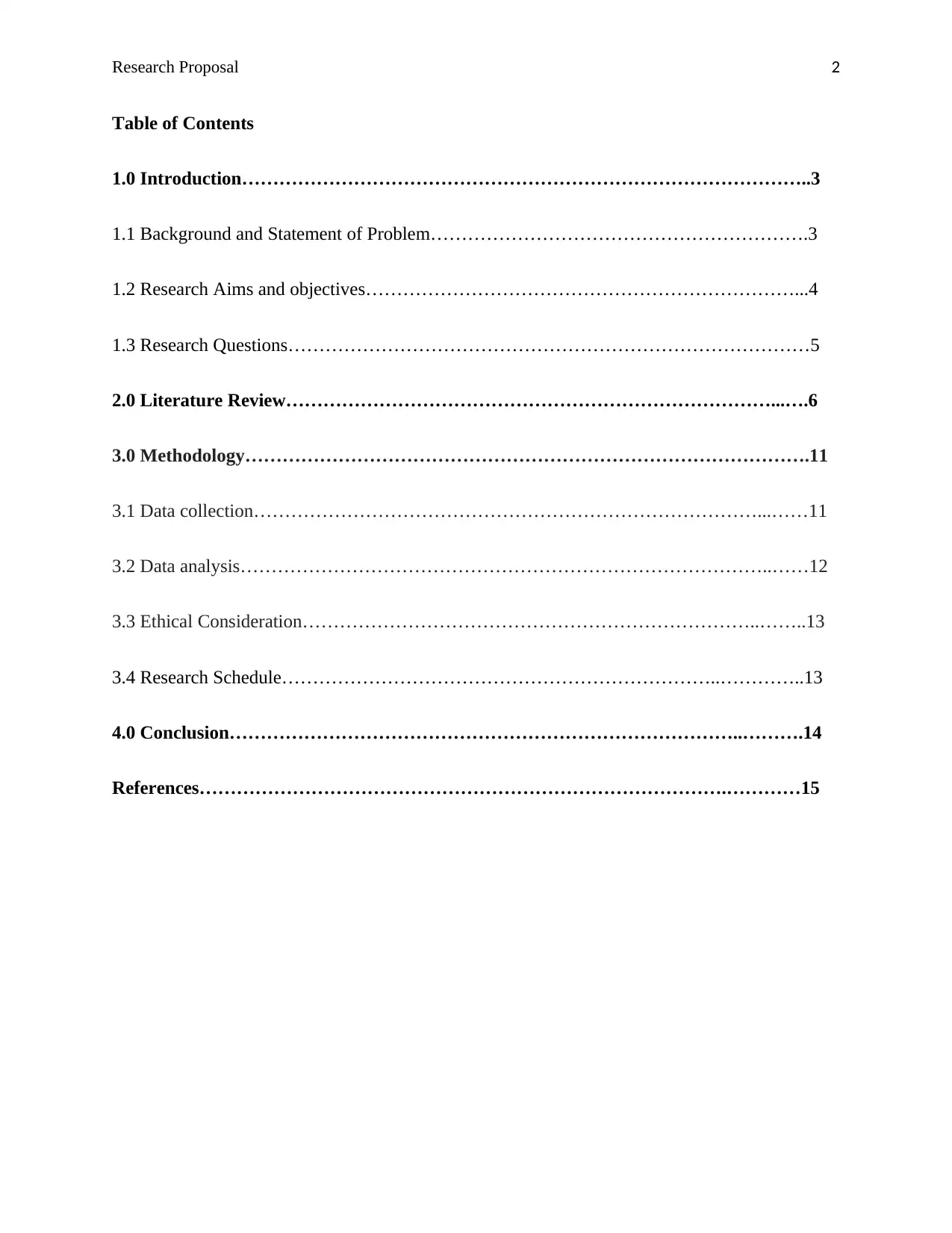
Research Proposal 2
Table of Contents
1.0 Introduction………………………………………………………………………………..3
1.1 Background and Statement of Problem…………………………………………………….3
1.2 Research Aims and objectives……………………………………………………………...4
1.3 Research Questions…………………………………………………………………………5
2.0 Literature Review……………………………………………………………………...….6
3.0 Methodology……………………………………………………………………………….11
3.1 Data collection………………………………………………………………………...……11
3.2 Data analysis…………………………………………………………………………..……12
3.3 Ethical Consideration………………………………………………………………..……..13
3.4 Research Schedule……………………………………………………………..…………..13
4.0 Conclusion………………………………………………………………………..……….14
References………………………………………………………………………….…………15
Table of Contents
1.0 Introduction………………………………………………………………………………..3
1.1 Background and Statement of Problem…………………………………………………….3
1.2 Research Aims and objectives……………………………………………………………...4
1.3 Research Questions…………………………………………………………………………5
2.0 Literature Review……………………………………………………………………...….6
3.0 Methodology……………………………………………………………………………….11
3.1 Data collection………………………………………………………………………...……11
3.2 Data analysis…………………………………………………………………………..……12
3.3 Ethical Consideration………………………………………………………………..……..13
3.4 Research Schedule……………………………………………………………..…………..13
4.0 Conclusion………………………………………………………………………..……….14
References………………………………………………………………………….…………15

Research Proposal 3
1.0 Introduction
1.1 Background and Statement of Problem
Organizational success and sustainability largely depends on the leadership approaches
which are established by the managers especially when it comes to managing the conflicts
associated with a multicultural environment(Behfarand Trochim, 2008). The workers, products
as well as services are core components of organizational continuity. Each of these elements
deserve the right attention in order to create the necessary equilibrium which is supportive to the
core objectives and values of an organization. In order to achieve this, there is the inevitable need
for the incorporation of best practices in terms of leadership and behavior management.
The corporate environment especially in the current set up is characterized by a
multicultural workforce. This becomes the case especially when the organization in question
operates within a large business environment. There are various challenges that come with
diversity in an organization. This therefore calls for the most effective strategies in ensuring that
the impacts of these conflicts are minimized as much as possible. A multicultural workforce may
arise as a result of variation in ages, levels of education, gender, class, positions within the
organizational hierarchy, religion and cultures just to mention but few. Apart from diversity,
variations in the nature of leadership approaches may lead to collision of interests especially
when the ideas are not welcome by a portion of the employees. Each of these situations lead to
the emergence of conflicts within the organization. Conflicts when not effectively managed may
turn into enormous problems for the organization. For instance when the differences occur
between the leaders and the workers, motivational levels, general output and the overall
productivity of the organization is greatly affected. Due to the detrimental nature of
organizational conflicts, it would be important to carry out a research on the measures that can be
1.0 Introduction
1.1 Background and Statement of Problem
Organizational success and sustainability largely depends on the leadership approaches
which are established by the managers especially when it comes to managing the conflicts
associated with a multicultural environment(Behfarand Trochim, 2008). The workers, products
as well as services are core components of organizational continuity. Each of these elements
deserve the right attention in order to create the necessary equilibrium which is supportive to the
core objectives and values of an organization. In order to achieve this, there is the inevitable need
for the incorporation of best practices in terms of leadership and behavior management.
The corporate environment especially in the current set up is characterized by a
multicultural workforce. This becomes the case especially when the organization in question
operates within a large business environment. There are various challenges that come with
diversity in an organization. This therefore calls for the most effective strategies in ensuring that
the impacts of these conflicts are minimized as much as possible. A multicultural workforce may
arise as a result of variation in ages, levels of education, gender, class, positions within the
organizational hierarchy, religion and cultures just to mention but few. Apart from diversity,
variations in the nature of leadership approaches may lead to collision of interests especially
when the ideas are not welcome by a portion of the employees. Each of these situations lead to
the emergence of conflicts within the organization. Conflicts when not effectively managed may
turn into enormous problems for the organization. For instance when the differences occur
between the leaders and the workers, motivational levels, general output and the overall
productivity of the organization is greatly affected. Due to the detrimental nature of
organizational conflicts, it would be important to carry out a research on the measures that can be
⊘ This is a preview!⊘
Do you want full access?
Subscribe today to unlock all pages.

Trusted by 1+ million students worldwide
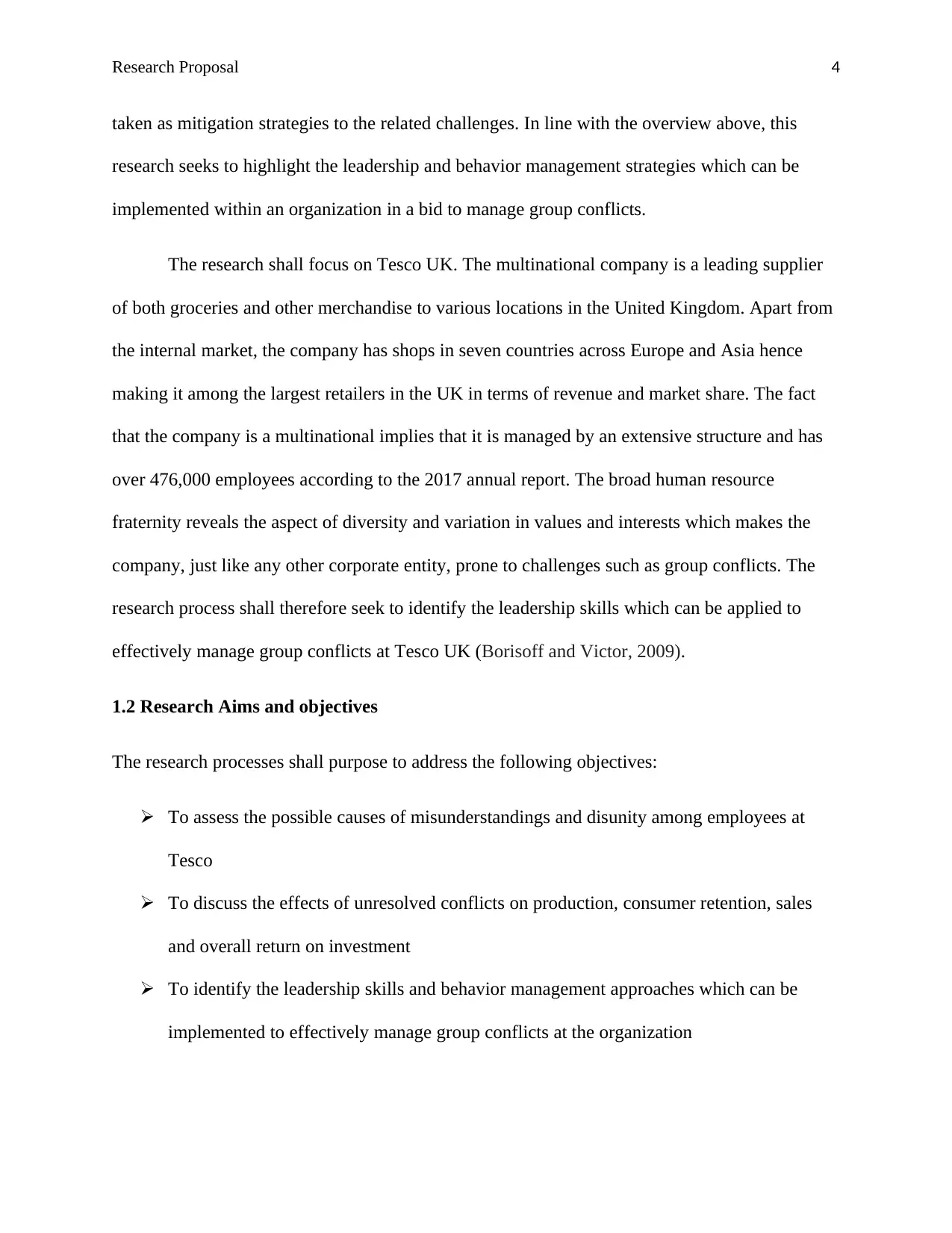
Research Proposal 4
taken as mitigation strategies to the related challenges. In line with the overview above, this
research seeks to highlight the leadership and behavior management strategies which can be
implemented within an organization in a bid to manage group conflicts.
The research shall focus on Tesco UK. The multinational company is a leading supplier
of both groceries and other merchandise to various locations in the United Kingdom. Apart from
the internal market, the company has shops in seven countries across Europe and Asia hence
making it among the largest retailers in the UK in terms of revenue and market share. The fact
that the company is a multinational implies that it is managed by an extensive structure and has
over 476,000 employees according to the 2017 annual report. The broad human resource
fraternity reveals the aspect of diversity and variation in values and interests which makes the
company, just like any other corporate entity, prone to challenges such as group conflicts. The
research process shall therefore seek to identify the leadership skills which can be applied to
effectively manage group conflicts at Tesco UK (Borisoff and Victor, 2009).
1.2 Research Aims and objectives
The research processes shall purpose to address the following objectives:
To assess the possible causes of misunderstandings and disunity among employees at
Tesco
To discuss the effects of unresolved conflicts on production, consumer retention, sales
and overall return on investment
To identify the leadership skills and behavior management approaches which can be
implemented to effectively manage group conflicts at the organization
taken as mitigation strategies to the related challenges. In line with the overview above, this
research seeks to highlight the leadership and behavior management strategies which can be
implemented within an organization in a bid to manage group conflicts.
The research shall focus on Tesco UK. The multinational company is a leading supplier
of both groceries and other merchandise to various locations in the United Kingdom. Apart from
the internal market, the company has shops in seven countries across Europe and Asia hence
making it among the largest retailers in the UK in terms of revenue and market share. The fact
that the company is a multinational implies that it is managed by an extensive structure and has
over 476,000 employees according to the 2017 annual report. The broad human resource
fraternity reveals the aspect of diversity and variation in values and interests which makes the
company, just like any other corporate entity, prone to challenges such as group conflicts. The
research process shall therefore seek to identify the leadership skills which can be applied to
effectively manage group conflicts at Tesco UK (Borisoff and Victor, 2009).
1.2 Research Aims and objectives
The research processes shall purpose to address the following objectives:
To assess the possible causes of misunderstandings and disunity among employees at
Tesco
To discuss the effects of unresolved conflicts on production, consumer retention, sales
and overall return on investment
To identify the leadership skills and behavior management approaches which can be
implemented to effectively manage group conflicts at the organization
Paraphrase This Document
Need a fresh take? Get an instant paraphrase of this document with our AI Paraphraser
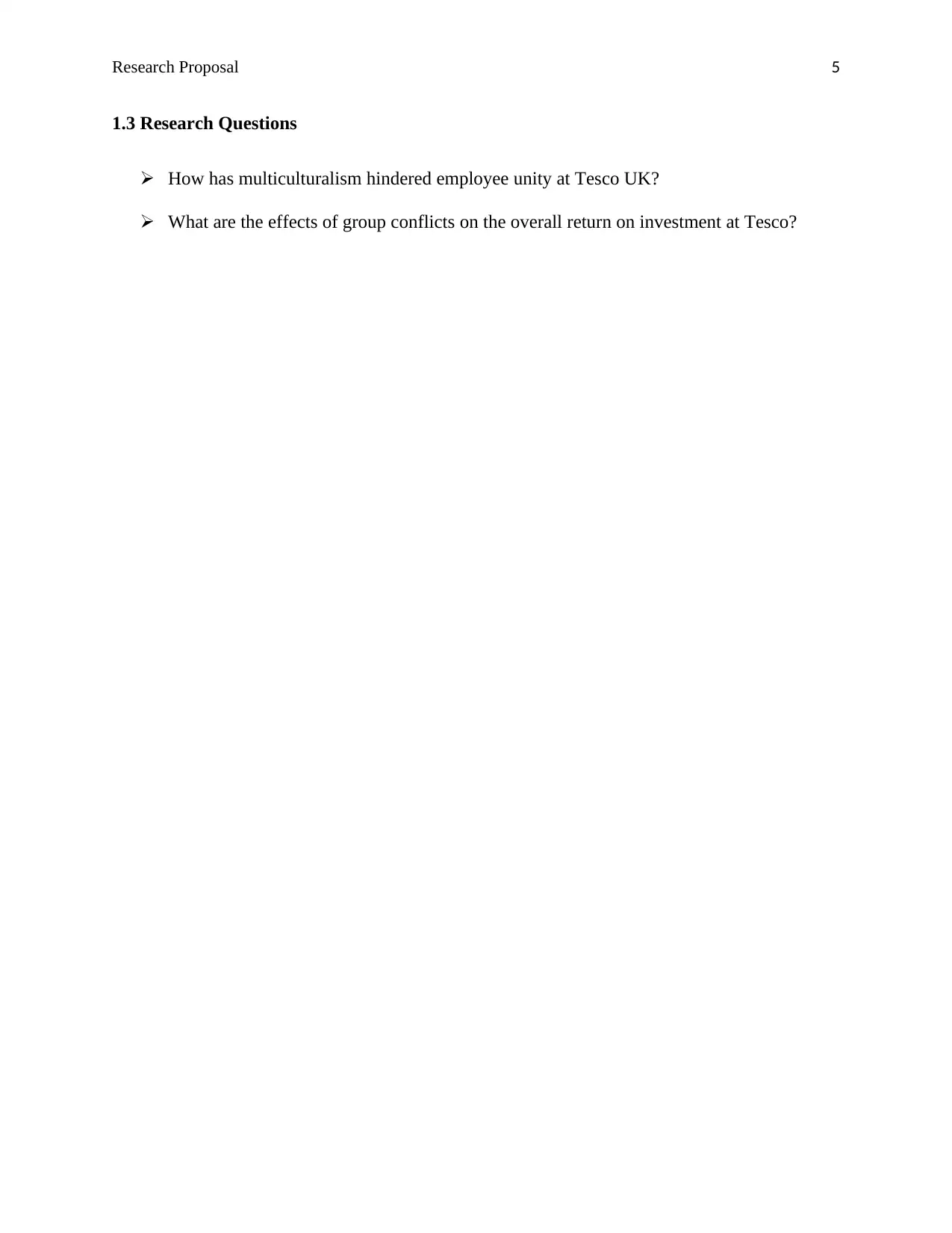
Research Proposal 5
1.3 Research Questions
How has multiculturalism hindered employee unity at Tesco UK?
What are the effects of group conflicts on the overall return on investment at Tesco?
1.3 Research Questions
How has multiculturalism hindered employee unity at Tesco UK?
What are the effects of group conflicts on the overall return on investment at Tesco?

Research Proposal 6
2.0 Literature Review
Causes of group conflicts
Lack of unity hence increased cost of production
Alper and Law (2010) discuss the challenges that are associated with group conflicts
within organizations. According to the authors, group conflicts lead diminished cohesion among
members which in turn affects the speed and flow of important processes. For instance in an
organization where the cost of production is directly connected to the time taken to complete
tasks, group conflicts lead to adverse effects since the activities are slowed down by the
misunderstandings. In the long run, the company ends up incurring a lot of production related
costs which then affects its revenue. The authors also point out that group conflicts and
misunderstandings may lead to poor utilization of company resources and facilities. In a situation
where the members are not on a level ground with regard to specific processes, the use of
resources becomes less coordinated which leads to misuse. Amason (2012) further identifies
group conflicts as one of the barriers to effective communication within an organization.
Variations in interests, ideas and values may lead to conflicts which in turn leads to prejudgment.
Having a preformed opinion towards an individual or a group of people largely influences the
way in which one receives information from them. As noted by the author, workplace diversity
leads to a myriad conflicts hence affecting the steady flow of information within the
organization. He therefore suggests staff training and empowerment on the specific company
procedures as a possible approach to minimalizing organizational conflicts. The channels of
communication also ought to be open while the organizational structure equally needs to be
inclusive of the varied needs of both the employees and the clients.
2.0 Literature Review
Causes of group conflicts
Lack of unity hence increased cost of production
Alper and Law (2010) discuss the challenges that are associated with group conflicts
within organizations. According to the authors, group conflicts lead diminished cohesion among
members which in turn affects the speed and flow of important processes. For instance in an
organization where the cost of production is directly connected to the time taken to complete
tasks, group conflicts lead to adverse effects since the activities are slowed down by the
misunderstandings. In the long run, the company ends up incurring a lot of production related
costs which then affects its revenue. The authors also point out that group conflicts and
misunderstandings may lead to poor utilization of company resources and facilities. In a situation
where the members are not on a level ground with regard to specific processes, the use of
resources becomes less coordinated which leads to misuse. Amason (2012) further identifies
group conflicts as one of the barriers to effective communication within an organization.
Variations in interests, ideas and values may lead to conflicts which in turn leads to prejudgment.
Having a preformed opinion towards an individual or a group of people largely influences the
way in which one receives information from them. As noted by the author, workplace diversity
leads to a myriad conflicts hence affecting the steady flow of information within the
organization. He therefore suggests staff training and empowerment on the specific company
procedures as a possible approach to minimalizing organizational conflicts. The channels of
communication also ought to be open while the organizational structure equally needs to be
inclusive of the varied needs of both the employees and the clients.
⊘ This is a preview!⊘
Do you want full access?
Subscribe today to unlock all pages.

Trusted by 1+ million students worldwide

Research Proposal 7
Ineffective leadership styles
Fisher (2010) points out that the leadership and behavior management approaches
embraced within an organization have a distinct influence on the emergence of conflicts within
the organization. The author notes that there are leadership approaches which lower worker
confidence, motivation and in some cases lead to resistance and grievances among the
employees. According to Fisher, an authoritative approach to leadership may not be effective
enough and when implemented in the wrong way may lead to group conflicts and
misunderstandings within the organization. The author suggests a more democratic approach in
which the needs of each member of the organization is adequately factored in. Effective
leadership spreads power across various position instead of congesting the authority on one
particular group or individuals. This therefore increases the confidence levels and the right
dissipation of power increases a sense of belonging and worth among the workers eventually
minimizing the related conflicts. The author equally points out effective decision making
approaches as one of the steps towards mitigating organizational conflicts. When some
individuals within the organization feel left out during crucial processes such as decision making
on an impending new project, they are likely to resist the change. Additionally, the level of
motivation and general output of the workers is lowered drastically. It is therefore recommended
that the process of decision making, as a leadership approach, ought to be all inclusive. This
implies that even the workers at the lowest level of the hierarchy ought to be involved in decision
making. When their opinions are taken in and used to make decisions, the occurrence of conflicts
is largely kept in check.
Ineffective leadership styles
Fisher (2010) points out that the leadership and behavior management approaches
embraced within an organization have a distinct influence on the emergence of conflicts within
the organization. The author notes that there are leadership approaches which lower worker
confidence, motivation and in some cases lead to resistance and grievances among the
employees. According to Fisher, an authoritative approach to leadership may not be effective
enough and when implemented in the wrong way may lead to group conflicts and
misunderstandings within the organization. The author suggests a more democratic approach in
which the needs of each member of the organization is adequately factored in. Effective
leadership spreads power across various position instead of congesting the authority on one
particular group or individuals. This therefore increases the confidence levels and the right
dissipation of power increases a sense of belonging and worth among the workers eventually
minimizing the related conflicts. The author equally points out effective decision making
approaches as one of the steps towards mitigating organizational conflicts. When some
individuals within the organization feel left out during crucial processes such as decision making
on an impending new project, they are likely to resist the change. Additionally, the level of
motivation and general output of the workers is lowered drastically. It is therefore recommended
that the process of decision making, as a leadership approach, ought to be all inclusive. This
implies that even the workers at the lowest level of the hierarchy ought to be involved in decision
making. When their opinions are taken in and used to make decisions, the occurrence of conflicts
is largely kept in check.
Paraphrase This Document
Need a fresh take? Get an instant paraphrase of this document with our AI Paraphraser
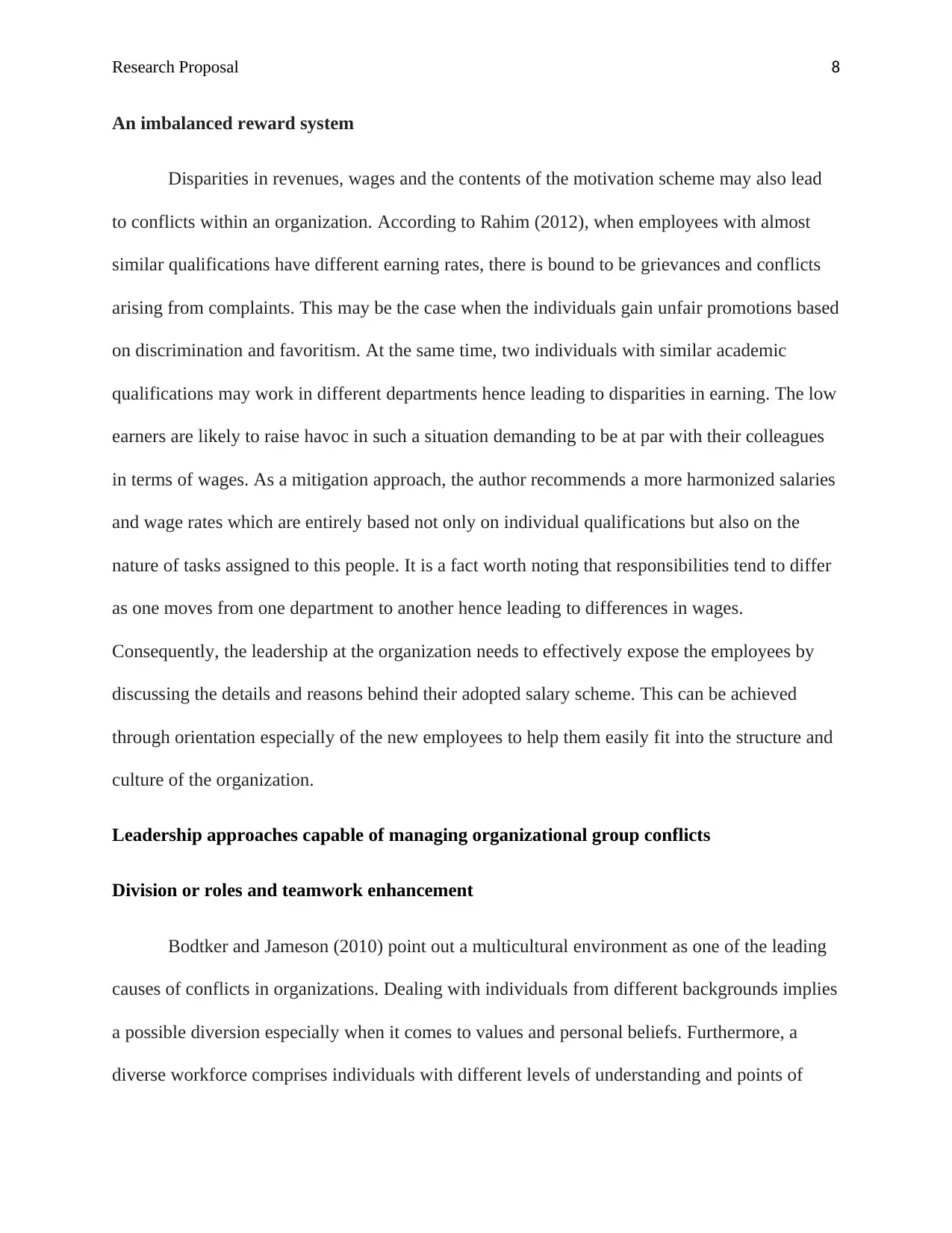
Research Proposal 8
An imbalanced reward system
Disparities in revenues, wages and the contents of the motivation scheme may also lead
to conflicts within an organization. According to Rahim (2012), when employees with almost
similar qualifications have different earning rates, there is bound to be grievances and conflicts
arising from complaints. This may be the case when the individuals gain unfair promotions based
on discrimination and favoritism. At the same time, two individuals with similar academic
qualifications may work in different departments hence leading to disparities in earning. The low
earners are likely to raise havoc in such a situation demanding to be at par with their colleagues
in terms of wages. As a mitigation approach, the author recommends a more harmonized salaries
and wage rates which are entirely based not only on individual qualifications but also on the
nature of tasks assigned to this people. It is a fact worth noting that responsibilities tend to differ
as one moves from one department to another hence leading to differences in wages.
Consequently, the leadership at the organization needs to effectively expose the employees by
discussing the details and reasons behind their adopted salary scheme. This can be achieved
through orientation especially of the new employees to help them easily fit into the structure and
culture of the organization.
Leadership approaches capable of managing organizational group conflicts
Division or roles and teamwork enhancement
Bodtker and Jameson (2010) point out a multicultural environment as one of the leading
causes of conflicts in organizations. Dealing with individuals from different backgrounds implies
a possible diversion especially when it comes to values and personal beliefs. Furthermore, a
diverse workforce comprises individuals with different levels of understanding and points of
An imbalanced reward system
Disparities in revenues, wages and the contents of the motivation scheme may also lead
to conflicts within an organization. According to Rahim (2012), when employees with almost
similar qualifications have different earning rates, there is bound to be grievances and conflicts
arising from complaints. This may be the case when the individuals gain unfair promotions based
on discrimination and favoritism. At the same time, two individuals with similar academic
qualifications may work in different departments hence leading to disparities in earning. The low
earners are likely to raise havoc in such a situation demanding to be at par with their colleagues
in terms of wages. As a mitigation approach, the author recommends a more harmonized salaries
and wage rates which are entirely based not only on individual qualifications but also on the
nature of tasks assigned to this people. It is a fact worth noting that responsibilities tend to differ
as one moves from one department to another hence leading to differences in wages.
Consequently, the leadership at the organization needs to effectively expose the employees by
discussing the details and reasons behind their adopted salary scheme. This can be achieved
through orientation especially of the new employees to help them easily fit into the structure and
culture of the organization.
Leadership approaches capable of managing organizational group conflicts
Division or roles and teamwork enhancement
Bodtker and Jameson (2010) point out a multicultural environment as one of the leading
causes of conflicts in organizations. Dealing with individuals from different backgrounds implies
a possible diversion especially when it comes to values and personal beliefs. Furthermore, a
diverse workforce comprises individuals with different levels of understanding and points of
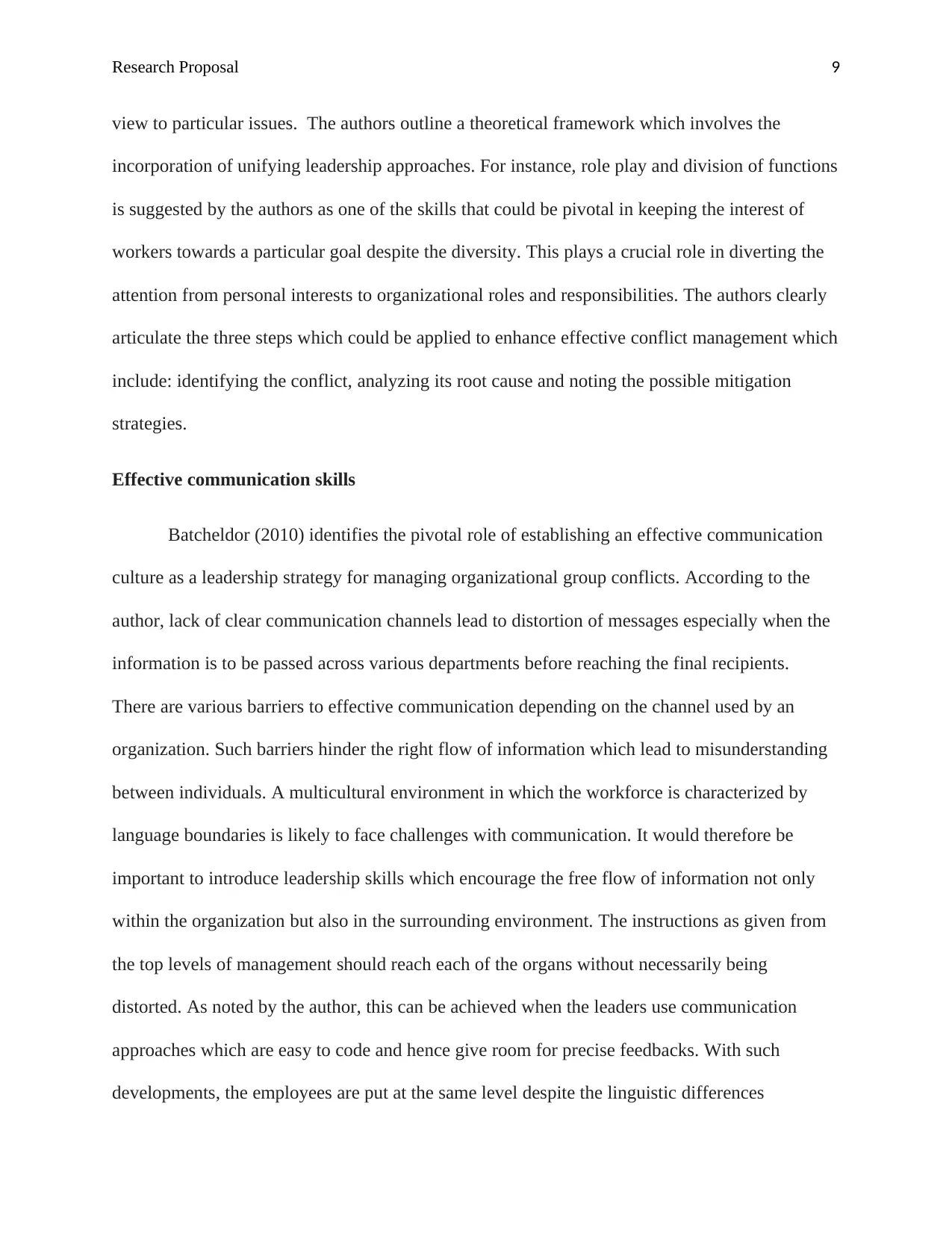
Research Proposal 9
view to particular issues. The authors outline a theoretical framework which involves the
incorporation of unifying leadership approaches. For instance, role play and division of functions
is suggested by the authors as one of the skills that could be pivotal in keeping the interest of
workers towards a particular goal despite the diversity. This plays a crucial role in diverting the
attention from personal interests to organizational roles and responsibilities. The authors clearly
articulate the three steps which could be applied to enhance effective conflict management which
include: identifying the conflict, analyzing its root cause and noting the possible mitigation
strategies.
Effective communication skills
Batcheldor (2010) identifies the pivotal role of establishing an effective communication
culture as a leadership strategy for managing organizational group conflicts. According to the
author, lack of clear communication channels lead to distortion of messages especially when the
information is to be passed across various departments before reaching the final recipients.
There are various barriers to effective communication depending on the channel used by an
organization. Such barriers hinder the right flow of information which lead to misunderstanding
between individuals. A multicultural environment in which the workforce is characterized by
language boundaries is likely to face challenges with communication. It would therefore be
important to introduce leadership skills which encourage the free flow of information not only
within the organization but also in the surrounding environment. The instructions as given from
the top levels of management should reach each of the organs without necessarily being
distorted. As noted by the author, this can be achieved when the leaders use communication
approaches which are easy to code and hence give room for precise feedbacks. With such
developments, the employees are put at the same level despite the linguistic differences
view to particular issues. The authors outline a theoretical framework which involves the
incorporation of unifying leadership approaches. For instance, role play and division of functions
is suggested by the authors as one of the skills that could be pivotal in keeping the interest of
workers towards a particular goal despite the diversity. This plays a crucial role in diverting the
attention from personal interests to organizational roles and responsibilities. The authors clearly
articulate the three steps which could be applied to enhance effective conflict management which
include: identifying the conflict, analyzing its root cause and noting the possible mitigation
strategies.
Effective communication skills
Batcheldor (2010) identifies the pivotal role of establishing an effective communication
culture as a leadership strategy for managing organizational group conflicts. According to the
author, lack of clear communication channels lead to distortion of messages especially when the
information is to be passed across various departments before reaching the final recipients.
There are various barriers to effective communication depending on the channel used by an
organization. Such barriers hinder the right flow of information which lead to misunderstanding
between individuals. A multicultural environment in which the workforce is characterized by
language boundaries is likely to face challenges with communication. It would therefore be
important to introduce leadership skills which encourage the free flow of information not only
within the organization but also in the surrounding environment. The instructions as given from
the top levels of management should reach each of the organs without necessarily being
distorted. As noted by the author, this can be achieved when the leaders use communication
approaches which are easy to code and hence give room for precise feedbacks. With such
developments, the employees are put at the same level despite the linguistic differences
⊘ This is a preview!⊘
Do you want full access?
Subscribe today to unlock all pages.

Trusted by 1+ million students worldwide
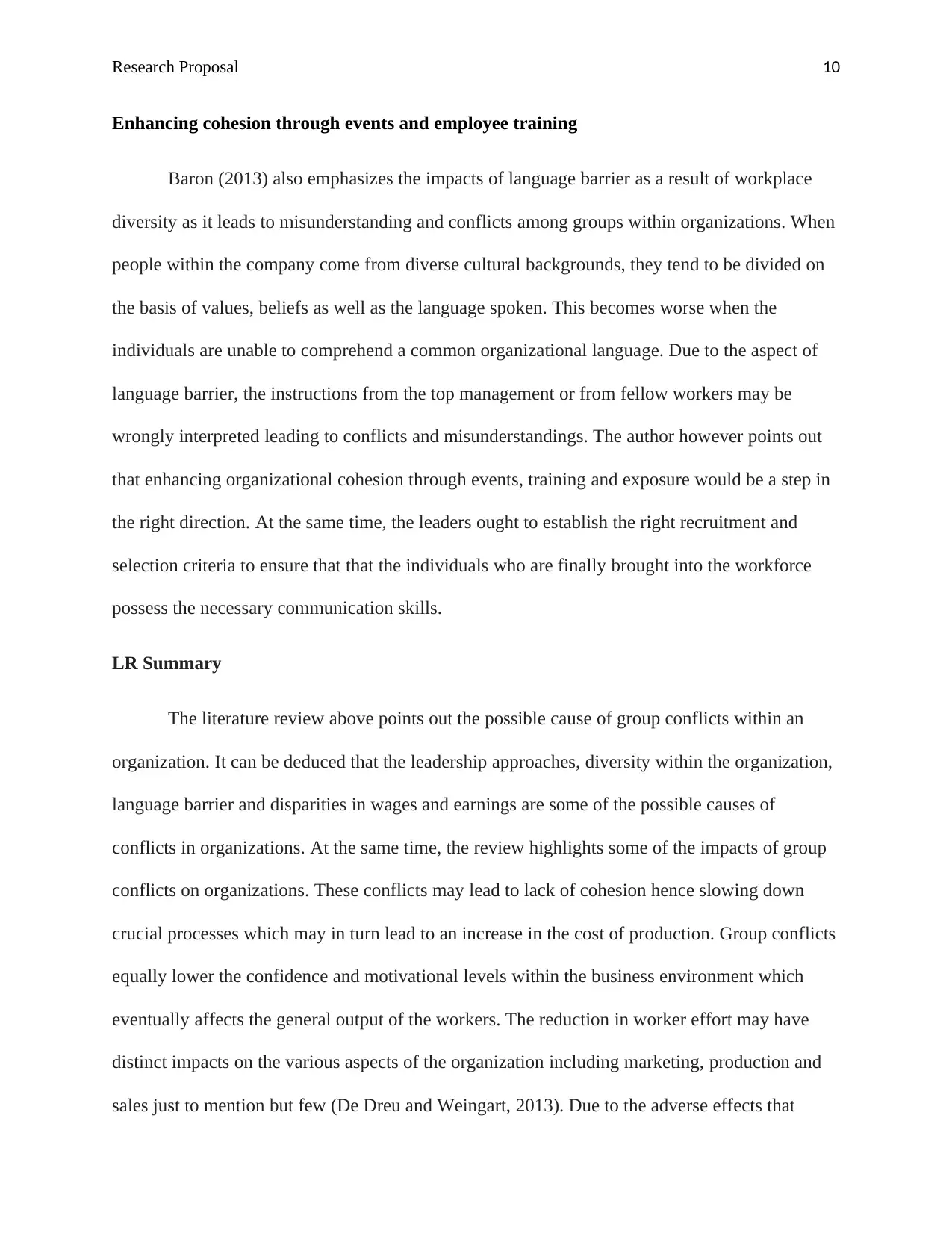
Research Proposal 10
Enhancing cohesion through events and employee training
Baron (2013) also emphasizes the impacts of language barrier as a result of workplace
diversity as it leads to misunderstanding and conflicts among groups within organizations. When
people within the company come from diverse cultural backgrounds, they tend to be divided on
the basis of values, beliefs as well as the language spoken. This becomes worse when the
individuals are unable to comprehend a common organizational language. Due to the aspect of
language barrier, the instructions from the top management or from fellow workers may be
wrongly interpreted leading to conflicts and misunderstandings. The author however points out
that enhancing organizational cohesion through events, training and exposure would be a step in
the right direction. At the same time, the leaders ought to establish the right recruitment and
selection criteria to ensure that that the individuals who are finally brought into the workforce
possess the necessary communication skills.
LR Summary
The literature review above points out the possible cause of group conflicts within an
organization. It can be deduced that the leadership approaches, diversity within the organization,
language barrier and disparities in wages and earnings are some of the possible causes of
conflicts in organizations. At the same time, the review highlights some of the impacts of group
conflicts on organizations. These conflicts may lead to lack of cohesion hence slowing down
crucial processes which may in turn lead to an increase in the cost of production. Group conflicts
equally lower the confidence and motivational levels within the business environment which
eventually affects the general output of the workers. The reduction in worker effort may have
distinct impacts on the various aspects of the organization including marketing, production and
sales just to mention but few (De Dreu and Weingart, 2013). Due to the adverse effects that
Enhancing cohesion through events and employee training
Baron (2013) also emphasizes the impacts of language barrier as a result of workplace
diversity as it leads to misunderstanding and conflicts among groups within organizations. When
people within the company come from diverse cultural backgrounds, they tend to be divided on
the basis of values, beliefs as well as the language spoken. This becomes worse when the
individuals are unable to comprehend a common organizational language. Due to the aspect of
language barrier, the instructions from the top management or from fellow workers may be
wrongly interpreted leading to conflicts and misunderstandings. The author however points out
that enhancing organizational cohesion through events, training and exposure would be a step in
the right direction. At the same time, the leaders ought to establish the right recruitment and
selection criteria to ensure that that the individuals who are finally brought into the workforce
possess the necessary communication skills.
LR Summary
The literature review above points out the possible cause of group conflicts within an
organization. It can be deduced that the leadership approaches, diversity within the organization,
language barrier and disparities in wages and earnings are some of the possible causes of
conflicts in organizations. At the same time, the review highlights some of the impacts of group
conflicts on organizations. These conflicts may lead to lack of cohesion hence slowing down
crucial processes which may in turn lead to an increase in the cost of production. Group conflicts
equally lower the confidence and motivational levels within the business environment which
eventually affects the general output of the workers. The reduction in worker effort may have
distinct impacts on the various aspects of the organization including marketing, production and
sales just to mention but few (De Dreu and Weingart, 2013). Due to the adverse effects that
Paraphrase This Document
Need a fresh take? Get an instant paraphrase of this document with our AI Paraphraser
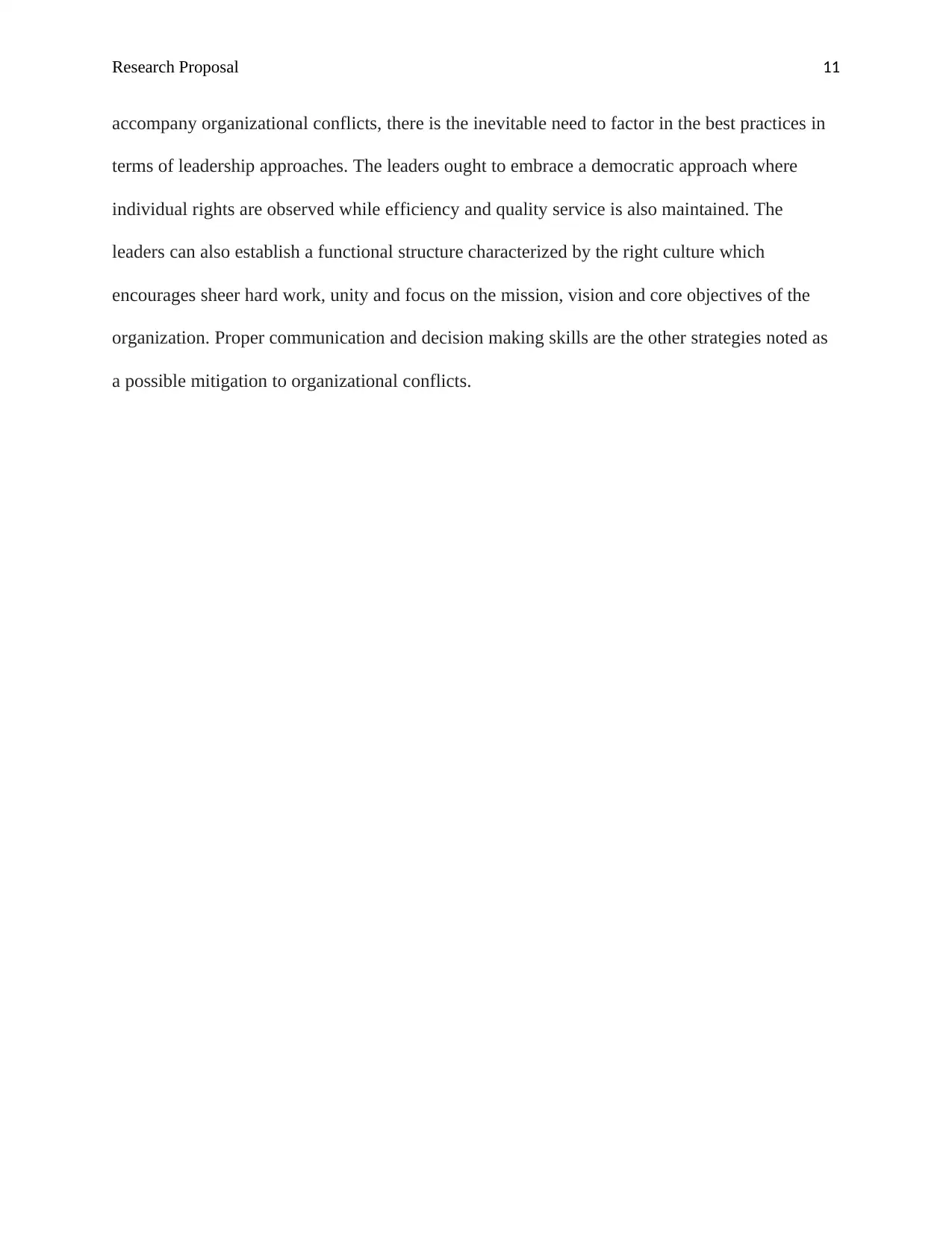
Research Proposal 11
accompany organizational conflicts, there is the inevitable need to factor in the best practices in
terms of leadership approaches. The leaders ought to embrace a democratic approach where
individual rights are observed while efficiency and quality service is also maintained. The
leaders can also establish a functional structure characterized by the right culture which
encourages sheer hard work, unity and focus on the mission, vision and core objectives of the
organization. Proper communication and decision making skills are the other strategies noted as
a possible mitigation to organizational conflicts.
accompany organizational conflicts, there is the inevitable need to factor in the best practices in
terms of leadership approaches. The leaders ought to embrace a democratic approach where
individual rights are observed while efficiency and quality service is also maintained. The
leaders can also establish a functional structure characterized by the right culture which
encourages sheer hard work, unity and focus on the mission, vision and core objectives of the
organization. Proper communication and decision making skills are the other strategies noted as
a possible mitigation to organizational conflicts.
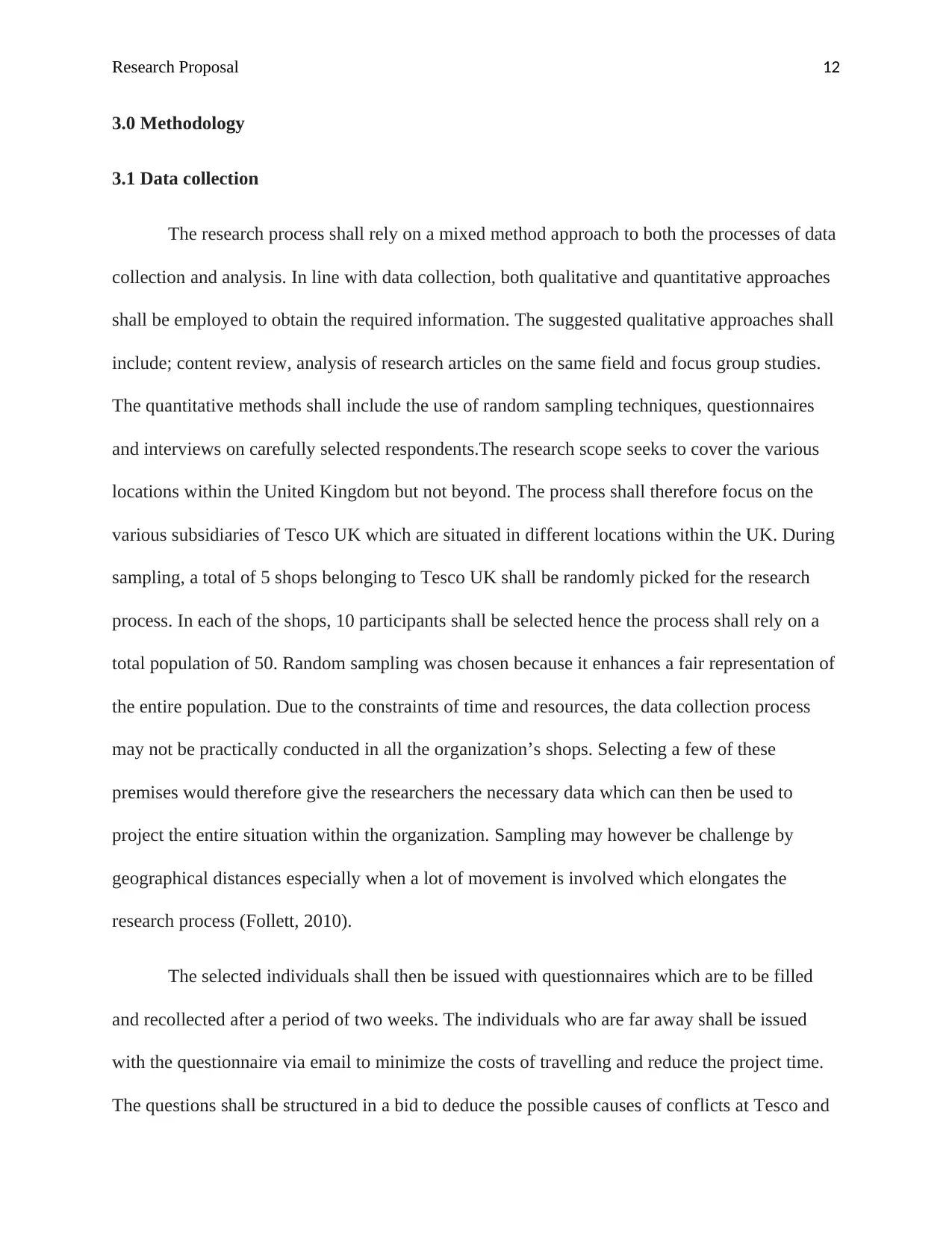
Research Proposal 12
3.0 Methodology
3.1 Data collection
The research process shall rely on a mixed method approach to both the processes of data
collection and analysis. In line with data collection, both qualitative and quantitative approaches
shall be employed to obtain the required information. The suggested qualitative approaches shall
include; content review, analysis of research articles on the same field and focus group studies.
The quantitative methods shall include the use of random sampling techniques, questionnaires
and interviews on carefully selected respondents.The research scope seeks to cover the various
locations within the United Kingdom but not beyond. The process shall therefore focus on the
various subsidiaries of Tesco UK which are situated in different locations within the UK. During
sampling, a total of 5 shops belonging to Tesco UK shall be randomly picked for the research
process. In each of the shops, 10 participants shall be selected hence the process shall rely on a
total population of 50. Random sampling was chosen because it enhances a fair representation of
the entire population. Due to the constraints of time and resources, the data collection process
may not be practically conducted in all the organization’s shops. Selecting a few of these
premises would therefore give the researchers the necessary data which can then be used to
project the entire situation within the organization. Sampling may however be challenge by
geographical distances especially when a lot of movement is involved which elongates the
research process (Follett, 2010).
The selected individuals shall then be issued with questionnaires which are to be filled
and recollected after a period of two weeks. The individuals who are far away shall be issued
with the questionnaire via email to minimize the costs of travelling and reduce the project time.
The questions shall be structured in a bid to deduce the possible causes of conflicts at Tesco and
3.0 Methodology
3.1 Data collection
The research process shall rely on a mixed method approach to both the processes of data
collection and analysis. In line with data collection, both qualitative and quantitative approaches
shall be employed to obtain the required information. The suggested qualitative approaches shall
include; content review, analysis of research articles on the same field and focus group studies.
The quantitative methods shall include the use of random sampling techniques, questionnaires
and interviews on carefully selected respondents.The research scope seeks to cover the various
locations within the United Kingdom but not beyond. The process shall therefore focus on the
various subsidiaries of Tesco UK which are situated in different locations within the UK. During
sampling, a total of 5 shops belonging to Tesco UK shall be randomly picked for the research
process. In each of the shops, 10 participants shall be selected hence the process shall rely on a
total population of 50. Random sampling was chosen because it enhances a fair representation of
the entire population. Due to the constraints of time and resources, the data collection process
may not be practically conducted in all the organization’s shops. Selecting a few of these
premises would therefore give the researchers the necessary data which can then be used to
project the entire situation within the organization. Sampling may however be challenge by
geographical distances especially when a lot of movement is involved which elongates the
research process (Follett, 2010).
The selected individuals shall then be issued with questionnaires which are to be filled
and recollected after a period of two weeks. The individuals who are far away shall be issued
with the questionnaire via email to minimize the costs of travelling and reduce the project time.
The questions shall be structured in a bid to deduce the possible causes of conflicts at Tesco and
⊘ This is a preview!⊘
Do you want full access?
Subscribe today to unlock all pages.

Trusted by 1+ million students worldwide
1 out of 18
Related Documents
Your All-in-One AI-Powered Toolkit for Academic Success.
+13062052269
info@desklib.com
Available 24*7 on WhatsApp / Email
![[object Object]](/_next/static/media/star-bottom.7253800d.svg)
Unlock your academic potential
Copyright © 2020–2025 A2Z Services. All Rights Reserved. Developed and managed by ZUCOL.





